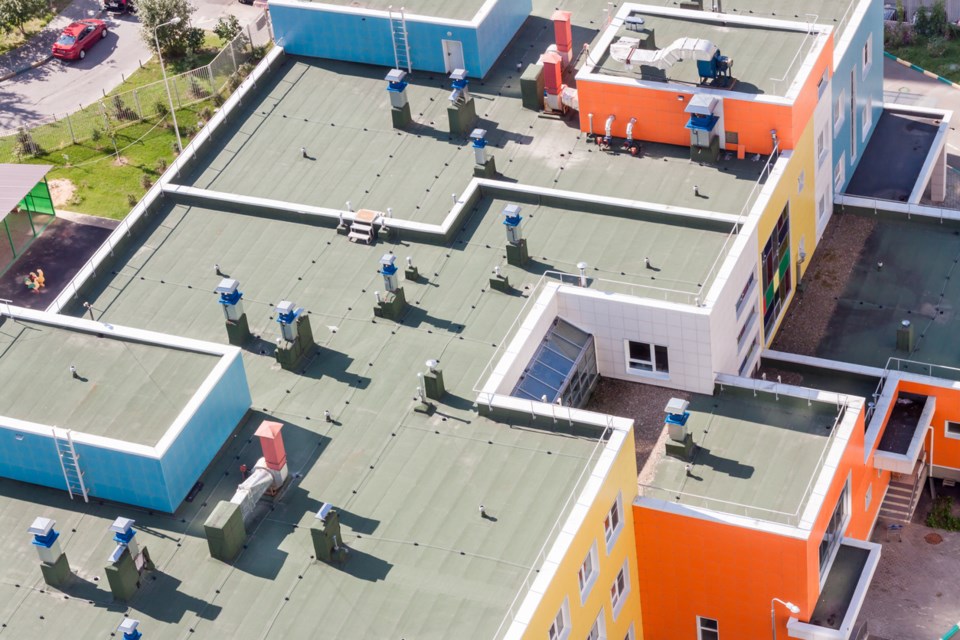Have you ever noticed on your travels that many residential buildings have pitched roofs, while commercial buildings tend to have flat ones?
Well, there are several reasons behind this trend.
Firstly, flat roofs are preferred by commercial businesses due to their cost effectiveness compared to sloped roofs. They are also easier to main, repair and safety to access, as they eliminate the need for dangerous climbs associated with steep pithes.
While cost implications are a cornerstone of any business, the primary reason commercial buildings often have flat roofs is something different altogether.
Often, commercial buildings need to use their roof space for heavy equipment, particularly for energy needs. These can include solar panels and HVAC units, which provide essential business services. Flat roofs are better at supporting these heavy loads than a sloped roof would be.
D’Angelo & Sons Roofing and Exteriors, a seasoned presence in the roofing industry, has been serving commercial properties in Hamilton for over 35 years. Read on to discover why flat roofs are prevalent in commercial buildings and how D’Angelo & Sons Roofing and Exteriors can assist with your roofing needs.
Flat roofs explained
What exactly is a flat roof? Quite simply, a flat roof is usually flat but can also incorporate roofs with a minimal slope, usually no more than 12 degrees, to help with building drainage.
Although flat roofing or low-slope roofing are less common in residential housing, they are common in commercial buildings such as office blocks, warehouses, factories, and other types of business premises.
Flat roofs are typically cheaper to build as they are made from inexpensive materials that are durable and easy to work with. Some are constructed from metal sheeting or an asphalt layer, while others are built with tiles. However, some businesses install flat roofs made of more expensive but longer-lasting and harder-wearing materials, such as PVC, EPDM, and TPO, to save money in the long term.
Where did flat roofs originate?
Flat roofs were initially built centuries ago in hot, dry environments, such as deserts, due to the year-round arid weather. With little wet weather and few rainstorms to contend with, drainage was not an essential consideration.
Meanwhile, castles and fortifications in more temperate climates were also built with flat roofs. This enabled the building of high towers to allow soldiers to have excellent lookout points and could also house heavy weaponry such as canons. Sloped roofs would have proven impractical in aiding castle defense against rampant attackers.
Why are commercial roofs flat?
All types of roofing have various pros and cons, and the right choice depends on each business’s needs. Here are some reasons why flat roofs are ideal for commercial businesses.
Quick installation
One of the critical advantages of flat roofs for commercial buildings is that they can be installed relatively quickly. Commercial builds often have tighter timelines than residential construction projects, making them appealing.
Additionally, flat roofs save businesses money over the long term as they require less maintenance and have quicker repair times than sloped roofs.
Provide excellent weight support
Flat roofs are more robust than sloped roofs, which can support heavy weights. Flat roofs provide the perfect surface area to store essential equipment, including HVAC units.
Easily accessible
Flat roofs can be accessed using internal or external staircases, making them highly accessible. As a result, it is safer when equipment, or the roofs themselves, need maintenance work. In addition, many businesses have used flat roofs to create roof terraces for employees to enjoy during lunch breaks.
Highly durable
Another considerableadvantage of flat roofs is the durability of the materials. They can often last for years – even decades – without requiring significant maintenance, even in areas with a high percentage of rainfall or exposure to high winds. In addition, flat roofs can be made of fire-resistant materials to aid the building’s safety rating.
How to maintain a flat roof
Like anything, flat roofs require regular maintenance to ensure they last for a long time without needing major repairs or replacing. The good news is that you can undertake much of this work yourself to keep costs to a minimum.Here are five tips to help your flat roof last.
Conduct regular inspections
Regular inspections are one of the best ways to ensure a roof lasts. Have it inspected at least once a year to help you identify any potential issues early on. The earlier problems are identified, the easier they are to fix.
Repair cracks immediately
If you notice any cracks or damage to the roof when you inspect it, get them repaired immediately. This will prevent the damage from worsening and leave you with a costly and unnecessary repair bill.
Clean regularly
Ensuring you clean your roof regularly to keep it free of dirt and debris that can build up, especially during inclement weather, helps to protect it from damage. This can be done with water and a stiff broom or brush or by contacting roofing professionals.
Keep gutters clear
While cleaning the roof, it’s crucial to ensure that gutters and run-offs are clear. Keeping them free of blockages and debris prevents water from collecting on the roof and causing damage.
Use anti-slip materials
Covering your roof in anti-slip materials, such as shingle or gravel, is one of the best ways of inspecting your roof safely without compromising safety. This will help you keep your foot if you need to carry out emergency inspections or repairs during wet weather.
The final word
Now you know the secrets behind why so many commercial buildings favor flat roofing over sloped roofs. While they look fantastic, they also provide businesses with many key functions and benefits that help them deliver value to their customers by keeping costs low.
If you’re in the GTA area and interested in finding out more about flat roofing systems for your commercial properties, contact D’Angelo & Sons Roofing and Exteriors today to discuss your options, and one of our team of experts will be able to assist you.
